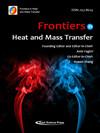EXAMINATION OF CONVECTIVE HEAT TRANSFER AND ENTROPY GENERATION BY TWO ADIABATIC OBSTACLES INSIDE A CAVITY AT DIFFERENT INCLINATION ANGLES
IF 1.1
Q4 THERMODYNAMICS
引用次数: 0
Abstract
This paper investigates numerically the problem of convective heat transfer and entropy generation by two adiabatic obstacles positioned inside a square cavity heated at the left wall and cooled on the right wall while horizontal walls are adiabatic. The inclination angle of the cavity orientation investigated are 30, 60 and 90 degrees. Rayleigh numbers ranging from 10 3 to 10 6 were calculated for two vertical obstacles. The method of Galerkin finite element was employed to solve the conservation equations of mass, momentum and energy. The cavity is assumed to be filled with air with Prandtl number of 0.71. It was observed that at 30 degree inclination, temperature distribution at the top of the cavity is more pronounced compared to the temperature at the lower region where adiabatic obstacles are positioned. Consequently, increase in Rayleigh number improve this behavior in all inclination angles considered. These results show that the effects of inclination angles and adiabatic obstacles on the thermal behaviours and fluid flow characteristics within the cavity are significantly evident. Rayleigh and Nusselt numbers strongly affect heat transfer rates proportionately. Also, high temperature gradients exist at regions where entropy is generated.不同倾角空腔内两个绝热障碍物对流换热和熵产的研究
本文数值研究了在水平壁面绝热的情况下,放置在方腔内的两个绝热障碍物左壁面受热右壁面受冷的对流换热和熵产问题。所研究的腔体取向倾角分别为30度、60度和90度。计算了两个垂直障碍物的瑞利数,范围为103 ~ 106。采用伽辽金有限元法求解了质量、动量和能量守恒方程。假设空腔内充满普朗特数为0.71的空气。观察到,当腔体倾角为30°时,腔体顶部的温度分布比底部有绝热障碍物的区域温度分布更为明显。因此,增加瑞利数可以改善所有倾角下的这一特性。这些结果表明,倾角和绝热障碍物对腔内热行为和流体流动特性的影响非常明显。瑞利数和努塞尔数成比例地强烈影响传热速率。此外,在产生熵的区域存在较高的温度梯度。
本文章由计算机程序翻译,如有差异,请以英文原文为准。
求助全文
约1分钟内获得全文
求助全文
来源期刊

Frontiers in Heat and Mass Transfer
THERMODYNAMICS-
CiteScore
2.50
自引率
61.10%
发文量
66
审稿时长
10 weeks
期刊介绍:
Frontiers in Heat and Mass Transfer is a free-access and peer-reviewed online journal that provides a central vehicle for the exchange of basic ideas in heat and mass transfer between researchers and engineers around the globe. It disseminates information of permanent interest in the area of heat and mass transfer. Theory and fundamental research in heat and mass transfer, numerical simulations and algorithms, experimental techniques and measurements as applied to all kinds of current and emerging problems are welcome. Contributions to the journal consist of original research on heat and mass transfer in equipment, thermal systems, thermodynamic processes, nanotechnology, biotechnology, information technology, energy and power applications, as well as security and related topics.
 求助内容:
求助内容: 应助结果提醒方式:
应助结果提醒方式:


